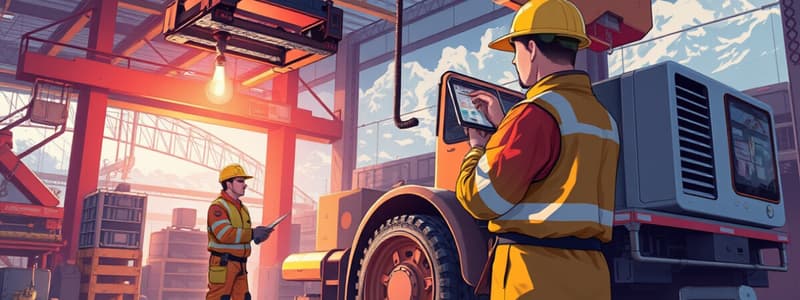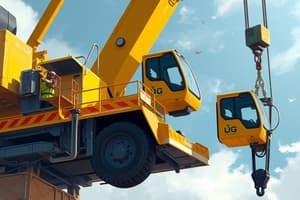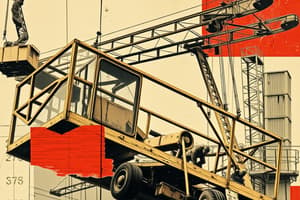Podcast
Questions and Answers
Who ultimately bears responsibility for ensuring that employees using equipment are competent?
Who ultimately bears responsibility for ensuring that employees using equipment are competent?
- The employees themselves
- The duty holder (employer) (correct)
- The equipment manufacturers
- External subcontractors only
What must a duty holder do when delegating legal obligations?
What must a duty holder do when delegating legal obligations?
- Ensure those undertaking the tasks are qualified and trained (correct)
- Ignore the need for training and assessment
- Fully transfer all responsibilities to subcontractors
- Only provide general instructions without further oversight
Which party is primarily responsible for the health and safety of users of lifting equipment?
Which party is primarily responsible for the health and safety of users of lifting equipment?
- Manufacturers have no obligations under current legislation
- Employees are not responsible for how equipment is used
- Importers and distributors hold no responsibility
- The duty holder assumes full legal liability (correct)
What is a key obligation of employees concerning the use of equipment?
What is a key obligation of employees concerning the use of equipment?
Which of the following is NOT a responsibility of suppliers within the supply chain?
Which of the following is NOT a responsibility of suppliers within the supply chain?
Which property of a material is characterized by its tendency to fracture with minimal force applied?
Which property of a material is characterized by its tendency to fracture with minimal force applied?
What ability defines a material's capacity to absorb energy and undergo plastic deformation without breaking?
What ability defines a material's capacity to absorb energy and undergo plastic deformation without breaking?
Which property allows a material, like a spring, to return to its original size after stress is removed?
Which property allows a material, like a spring, to return to its original size after stress is removed?
Which term refers to the permanent change in shape of a material under compressive force?
Which term refers to the permanent change in shape of a material under compressive force?
What is the term for the electrochemical process that leads to the deterioration of metals, like rusting?
What is the term for the electrochemical process that leads to the deterioration of metals, like rusting?
What is the Mechanical Advantage when the load is 300kg and the effort is 50kg?
What is the Mechanical Advantage when the load is 300kg and the effort is 50kg?
What is primarily required for measuring devices according to technical requirements?
What is primarily required for measuring devices according to technical requirements?
What is the Velocity Ratio if the distance moved by the effort is 75m and the distance moved by the load is 3m?
What is the Velocity Ratio if the distance moved by the effort is 75m and the distance moved by the load is 3m?
Which basic crack detection methods are most commonly used for general lifting equipment?
Which basic crack detection methods are most commonly used for general lifting equipment?
Which of the following statements accurately describes efficiency in machines?
Which of the following statements accurately describes efficiency in machines?
What is a characteristic of precision measuring equipment compared to general measuring devices?
What is a characteristic of precision measuring equipment compared to general measuring devices?
Which of the following describes a highly inefficient machine?
Which of the following describes a highly inefficient machine?
Which of the following crack detection methods requires a higher level of training to interpret the results?
Which of the following crack detection methods requires a higher level of training to interpret the results?
What is the purpose of calculating the Velocity Ratio?
What is the purpose of calculating the Velocity Ratio?
What type of equipment is typically involved in high-cost crack detection examinations?
What type of equipment is typically involved in high-cost crack detection examinations?
What would reflect a good efficiency rating in a machine?
What would reflect a good efficiency rating in a machine?
Which factor is essential for the accuracy of load tests?
Which factor is essential for the accuracy of load tests?
In the context of Mechanical Advantage, which calculation demonstrates a ratio relationship?
In the context of Mechanical Advantage, which calculation demonstrates a ratio relationship?
Which statement is true regarding the cost-effectiveness of basic crack detection?
Which statement is true regarding the cost-effectiveness of basic crack detection?
What is a key limitation of a machine's ability to achieve high Mechanical Advantage?
What is a key limitation of a machine's ability to achieve high Mechanical Advantage?
What is the fundamental requirement of trained operatives who perform crack detection tests?
What is the fundamental requirement of trained operatives who perform crack detection tests?
What is the primary purpose of conducting regular inspections on lifting equipment?
What is the primary purpose of conducting regular inspections on lifting equipment?
Which of the following statements correctly reflects the term 'lifting accessory'?
Which of the following statements correctly reflects the term 'lifting accessory'?
In the context of lifting equipment legislation, how are accessories regarded in relation to the load?
In the context of lifting equipment legislation, how are accessories regarded in relation to the load?
What is a critical action to be taken when an inspection reveals the need for repairs?
What is a critical action to be taken when an inspection reveals the need for repairs?
Why is having a robust inspection regime for lifting equipment considered important?
Why is having a robust inspection regime for lifting equipment considered important?
What is one benefit of familiarizing oneself with the equipment during inspections?
What is one benefit of familiarizing oneself with the equipment during inspections?
What should be concluded if an inspection reveals that lifting accessories are free from defects?
What should be concluded if an inspection reveals that lifting accessories are free from defects?
What does the term 'competent person' in relation to inspections imply?
What does the term 'competent person' in relation to inspections imply?
Flashcards are hidden until you start studying
Study Notes
Duty Holder Responsibilities
- Duty holders must ensure subcontractors are qualified, experienced, and adequately trained for their tasks.
- Employees must be assessed and trained properly and provided with the necessary equipment.
- Procedures should be established for vetting external organizations’ competency.
- Users and those in the supply chain share responsibilities for health and safety regarding lifting equipment.
- Ultimate responsibility falls on the employer while employees must use equipment according to their training.
- Manufacturers, alongside importers and distributors, have legal obligations regarding the safety and functionality of lifting equipment.
Importance of Regular Equipment Inspection
- Inspections confirm the safety of equipment for continued use.
- Competency is verified by ensuring users are trained adequately for equipment operation.
- Inspections help identify necessary repairs to maintain safe operation.
- Regular checks ensure equipment is functioning correctly and safely to prevent accidents.
- Familiarization with equipment enhances user efficiency and safety.
Lifting Equipment Overview
- Lifting Equipment includes all types of lifting appliances and accessories (e.g., gear, tackle).
- Lifting Accessories connect loads to lifting appliances and may be included in supply legislation.
- Accessories incorporated into loads must meet strength requirements and be free from defects but are not always subject to inspection regulations.
Material Properties
- Brittleness: Material tendency to fracture under minimal force; opposite of toughness.
- Elasticity: Ability of a material to return to original dimensions after stress removal.
- Plasticity: Material's capability to retain new dimensions once stress is removed.
- Toughness: Energy absorption capacity of material without fracturing.
- Hardness: Resistance to permanent shape change under compressive forces.
- Corrosion: Electrochemical oxidation of metals; rusting is a notable example.
Mechanical Advantage Calculation
- Absolute ratio of load (300kg) to effort (50kg) is a critical assessment of equipment efficiency.
Velocity Ratio (VR)
- Machines move large loads with small forces, necessitating greater effort distance in exchange for less load distance.
- VR formula: Distance moved by effort ÷ Distance moved by load.
Efficiency of Machines
- Machines aim to minimize energy wastage and maximize energy transfer from input to output.
- Efficiency reflects the device's ability to convert input energy into useful energy stores.
Load Testing and Measurement Accuracy
- Load test conductors must understand limitations of machinery and ensure accuracy according to standards.
- LEEA Technical Requirements mandate checking and verifying measuring devices regularly.
Crack Detection Methods
- Basic crack detection techniques examine welds using methods like dye penetration or magnetic particle tests.
- Advanced detection methods (eddy current, radiography, ultrasonic) are available for high-value or safety-critical items but require specialized training.
Studying That Suits You
Use AI to generate personalized quizzes and flashcards to suit your learning preferences.




